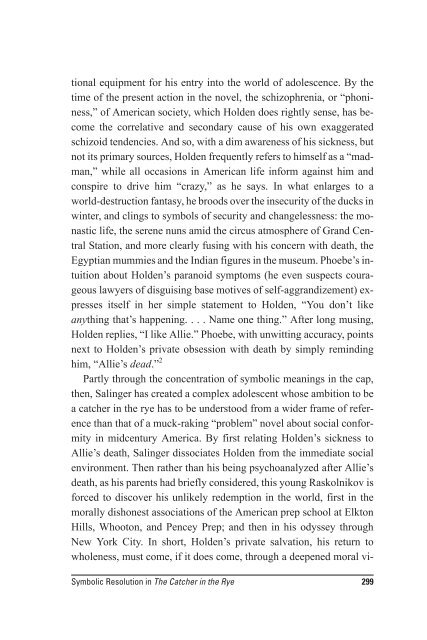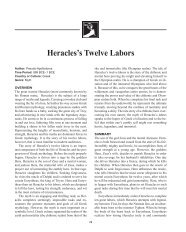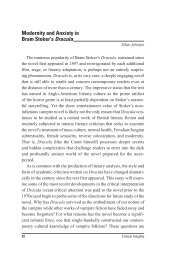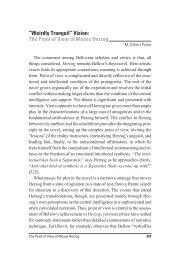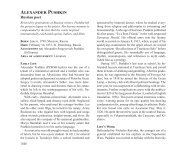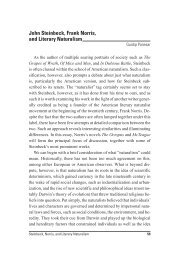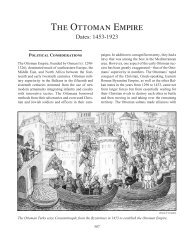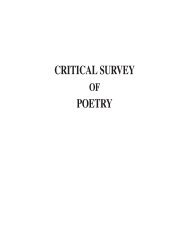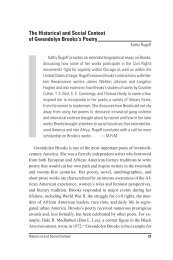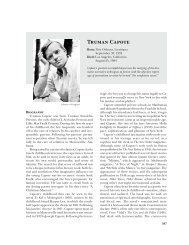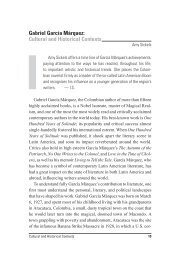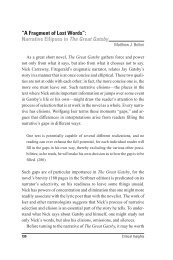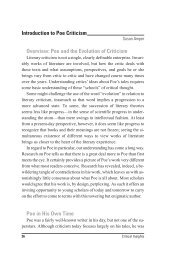Catcher in the Rye.vp - Salem Press
Catcher in the Rye.vp - Salem Press
Catcher in the Rye.vp - Salem Press
Create successful ePaper yourself
Turn your PDF publications into a flip-book with our unique Google optimized e-Paper software.
tional equipment for his entry <strong>in</strong>to <strong>the</strong> world of adolescence. By <strong>the</strong><br />
time of <strong>the</strong> present action <strong>in</strong> <strong>the</strong> novel, <strong>the</strong> schizophrenia, or “phon<strong>in</strong>ess,”<br />
of American society, which Holden does rightly sense, has become<br />
<strong>the</strong> correlative and secondary cause of his own exaggerated<br />
schizoid tendencies. And so, with a dim awareness of his sickness, but<br />
not its primary sources, Holden frequently refers to himself as a “madman,”<br />
while all occasions <strong>in</strong> American life <strong>in</strong>form aga<strong>in</strong>st him and<br />
conspire to drive him “crazy,” as he says. In what enlarges to a<br />
world-destruction fantasy, he broods over <strong>the</strong> <strong>in</strong>security of <strong>the</strong> ducks <strong>in</strong><br />
w<strong>in</strong>ter, and cl<strong>in</strong>gs to symbols of security and changelessness: <strong>the</strong> monastic<br />
life, <strong>the</strong> serene nuns amid <strong>the</strong> circus atmosphere of Grand Central<br />
Station, and more clearly fus<strong>in</strong>g with his concern with death, <strong>the</strong><br />
Egyptian mummies and <strong>the</strong> Indian figures <strong>in</strong> <strong>the</strong> museum. Phoebe’s <strong>in</strong>tuition<br />
about Holden’s paranoid symptoms (he even suspects courageous<br />
lawyers of disguis<strong>in</strong>g base motives of self-aggrandizement) expresses<br />
itself <strong>in</strong> her simple statement to Holden, “You don’t like<br />
anyth<strong>in</strong>g that’s happen<strong>in</strong>g. . . . Name one th<strong>in</strong>g.” After long mus<strong>in</strong>g,<br />
Holden replies, “I like Allie.” Phoebe, with unwitt<strong>in</strong>g accuracy, po<strong>in</strong>ts<br />
next to Holden’s private obsession with death by simply rem<strong>in</strong>d<strong>in</strong>g<br />
him, “Allie’s dead.” 2<br />
Partly through <strong>the</strong> concentration of symbolic mean<strong>in</strong>gs <strong>in</strong> <strong>the</strong> cap,<br />
<strong>the</strong>n, Sal<strong>in</strong>ger has created a complex adolescent whose ambition to be<br />
a catcher <strong>in</strong> <strong>the</strong> rye has to be understood from a wider frame of reference<br />
than that of a muck-rak<strong>in</strong>g “problem” novel about social conformity<br />
<strong>in</strong> midcentury America. By first relat<strong>in</strong>g Holden’s sickness to<br />
Allie’s death, Sal<strong>in</strong>ger dissociates Holden from <strong>the</strong> immediate social<br />
environment. Then ra<strong>the</strong>r than his be<strong>in</strong>g psychoanalyzed after Allie’s<br />
death, as his parents had briefly considered, this young Raskolnikov is<br />
forced to discover his unlikely redemption <strong>in</strong> <strong>the</strong> world, first <strong>in</strong> <strong>the</strong><br />
morally dishonest associations of <strong>the</strong> American prep school at Elkton<br />
Hills, Whooton, and Pencey Prep; and <strong>the</strong>n <strong>in</strong> his odyssey through<br />
New York City. In short, Holden’s private salvation, his return to<br />
wholeness, must come, if it does come, through a deepened moral vi-<br />
Symbolic Resolution <strong>in</strong> The <strong>Catcher</strong> <strong>in</strong> <strong>the</strong> <strong>Rye</strong> 299


